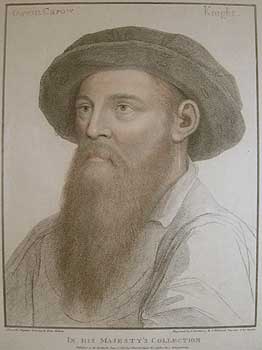Thos-Elli.jpg)
Th: Elliott Knight
1794 white Lines: 11 x 8 Plate: 13 1/8 x 13 3/8 no colour sepia stipple double matted white-wood Fame: 21 3/8 x 17 5/8"
Ref. SB8 (161) /DVL/ s.andv> RVL PRICE CODE B
Th: Eliott Knight. Sir Thomas Elyot (c.1490-1546) was a writer and diplomat, and was well respected by his contemporaries in both fields. His most famous publication was The ‘Boke named the Governour’, a book of political instruction inspired by classical literature, which was first issued in 1531 and was reprinted a number of times. He also published a comprehensive Latin-English dictionary, and a popular guide to medicine. His work as ambassador to Charles V took him to the continent, where he visited the city of Nuremberg four years after Dürer’s death. Holbein’s portrait was probably made after Elyot returned from this embassy, on which he had been replaced as ambassador by Thomas Cranmer. Holbein has shown Elyot dressed in a cap and gown with a fur collar, over which he wears a cross on a long chain. The work was a pendant to Holbein’s drawing of Sir Thomas’s wife Margaret.
-_DVL_-.jpg)
The Lady Hobbie/ Hobby
1793 white, some discolouration. no matt. Lines: 11 3/8 x 7 3/4" Plate: 13 1/2 x 10" white-wood Frame: 23 1/4 x 18"
Ref. SB13 (161) /DVL/ s.andv> RVL PRICE CODE B
Elizabeth, Lady Hoby was a member of Queen Catherine Parr’s circle circle. She was the daughter of Sir Walter Stonor, the Lieutenant of the Tower of London, and the wife of Sir Philip Hoby, the ambassador to the Holy Roman Empire and Flanders.




-_DVL_-.jpg)



-_DVL_-.jpg)
-_DVL_-.jpg)
-_DVL_-.jpg)
-_DVL_-.jpg)
-Duke-of-.jpg)

Thos-Elli.jpg)
-_DVL_-.jpg)
-_DVL_-s.jpg)
